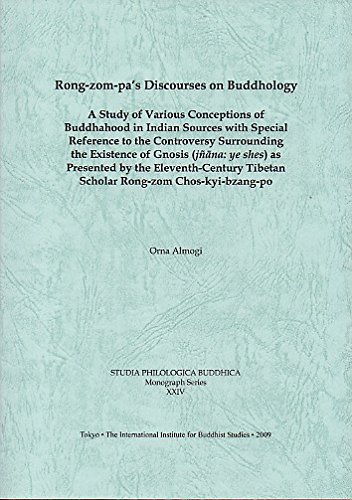|
|
| (7 intermediate revisions by the same user not shown) |
| Line 1: |
Line 1: |
| {{Book | | {{Book |
| | |BookPerson={{Book-person |
| | |PersonPage=Almogi, O. |
| | |PersonName=Orna Almolgi |
| | }}{{Book-person |
| | |PersonPage=Rong zom chos kyi bzang po |
| | |PersonName=Rongzom Chökyi Zangpo |
| | }} |
| |FullTextRead=No | | |FullTextRead=No |
| |BookToc=*{{i|'''Preface'''|13}} | | |BookToc=*{{i|'''Preface'''|13}} |
| Line 5: |
Line 12: |
| <center>'''Introduction'''</center> | | <center>'''Introduction'''</center> |
|
| |
|
| *{{i|'''Chapter 1: Rong-zoin-pa's Discussion of the Controversy Surrounding the<br> Constituents of Buddhahood: An Overview'''|23}} | | *{{i|'''Chapter 1: Rong-zom-pa's Discussion of the Controversy Surrounding the<br> Constituents of Buddhahood: An Overview'''|23}} |
| **{{i|1. Introductory Remarks|23}} | | **{{i|1. Introductory Remarks|23}} |
| **{{i|2. Various Positions regarding the Constituents of Buddhahood|25}} | | **{{i|2. Various Positions regarding the Constituents of Buddhahood|25}} |
| Line 19: |
Line 26: |
| *{{i|'''Chapter 2: Buddhology in Its Historical and Philosophical Context:<br> An Overview'''|45}} | | *{{i|'''Chapter 2: Buddhology in Its Historical and Philosophical Context:<br> An Overview'''|45}} |
| **{{i|1. Introductory Remarks|45}} | | **{{i|1. Introductory Remarks|45}} |
| **{{i|2. Non-Mahayana Buddhology|47}} | | **{{i|2. Non-Mahāyāna Buddhology|47}} |
| ***{{i|A. Nirvāṇa without Remains and the Indirect Activities of the<br> Buddha in the World|47}} | | ***{{i|A. Nirvāṇa without Remains and the Indirect Activities of the<br> Buddha in the World|47}} |
| ***{{i|B. The Notions of Transcendental and Multiple Buddhas and<br> Their Fields|51}} | | ***{{i|B. The Notions of Transcendental and Multiple ''Buddhas'' and<br> Their Fields|51}} |
| **{{i|3. Non-Tantric Mahāyāna Buddhology|53}} | | **{{i|3. Non-Tantric Mahāyāna Buddhology|53}} |
| ***{{i|A. The True Nature of the World as ''Nirvāṇa'' and the Inconceivability of<br> Buddhahood|56}} | | ***{{i|A. The True Nature of the World as ''Nirvāṇa'' and the Inconceivability of<br> Buddhahood|56}} |
| Line 29: |
Line 36: |
| ***{{i|E. The Notion of Bliss|70}} | | ***{{i|E. The Notion of Bliss|70}} |
| **{{i|4. Tantric Buddhology|76}} | | **{{i|4. Tantric Buddhology|76}} |
| ***{{i|A. ''Mantras, Vidyās, and Dhāraṇīs''|81}} | | ***{{i|A. ''Mantras'', ''Vidyās'', and ''Dhāraṇīs''|81}} |
| ***{{i|B. ''Mudrās''|88}} | | ***{{i|B. ''Mudrās''|88}} |
| ***{{i|C. Manifold Expressions of Buddhahood|106}} | | ***{{i|C. Manifold Expressions of Buddhahood|106}} |
| Line 41: |
Line 48: |
| **{{i|5. Concluding Remarks|137}} | | **{{i|5. Concluding Remarks|137}} |
|
| |
|
| *{{i|'''Chapter 3: The Controversy Surrounding the Existence of Gnosis at<br> the Stage of a Buddha'''|139}} | | *{{i|'''Chapter 3: The Controversy Surrounding the Existence of Gnosis at<br> the Stage of a ''Buddha'' '''|139}} |
| **{{i|1. Introductory Remarks|139}} | | **{{i|1. Introductory Remarks|139}} |
| **{{i|2. The Problem of Ascribing a Mental Element to the Absolute|139}} | | **{{i|2. The Problem of Ascribing a Mental Element to the Absolute|139}} |
| Line 57: |
Line 64: |
| *****{{i|(d) Candraharipāda|180}} | | *****{{i|(d) Candraharipāda|180}} |
| *****{{i|(e) Bhavya|180}} | | *****{{i|(e) Bhavya|180}} |
| ****{{i|(ii) Proponents of the Existence of the Purified Dharmadhātu and<br> Non-Conceptual Gnosis (Position 2)|181}} | | ****{{i|(ii) Proponents of the Existence of the Purified ''Dharmadhātu'' and<br> Non-Conceptual Gnosis (Position 2)|181}} |
| *****{{i|(a) Nāgamitra and Jñānacandra|181}} | | *****{{i|(a) Nāgamitra and Jñānacandra|181}} |
| *****{{i|(b) Dharmamitra|182}} | | *****{{i|(b) Dharmamitra|182}} |
| Line 68: |
Line 75: |
| **{{i|7. Concluding Remarks|187}} | | **{{i|7. Concluding Remarks|187}} |
|
| |
|
| *{{i|'''Chapter 4: Rong-zom-pa's Position on Whether Gnosis Exists at the<br> Stage of a Buddha'''|189}} | | *{{i|'''Chapter 4: Rong-zom-pa's Position on Whether Gnosis Exists at the<br> Stage of a ''Buddha'' '''|189}} |
| **{{i|1. Introductory Remarks|189}} | | **{{i|1. Introductory Remarks|189}} |
| **{{i|2. Rong-zom-pa's View regarding the Existence of Gnosis at the<br> Stage of a Buddha as Addressed by Mi-pham|193}} | | **{{i|2. Rong-zom-pa's View regarding the Existence of Gnosis at the<br> Stage of a Buddha as Addressed by Mi-pham|193}} |
| Line 84: |
Line 91: |
|
| |
|
| *{{i|A Note on the Annotated Translations|235}} | | *{{i|A Note on the Annotated Translations|235}} |
| *{{i|'''The Sangs rgyas kyi sa chen mo'''|237}} | | *{{i|'''The ''Sangs rgyas kyi sa chen mo'' '''|237}} |
| **{{i|1. An Outline of the Text|237}} | | **{{i|1. An Outline of the Text|237}} |
| **{{i|2. An Annotated Translation|239}} | | **{{i|2. An Annotated Translation|239}} |
| Line 127: |
Line 134: |
| ***{{i|D. Candraharipāda's ''Ratnamālā''|436}} | | ***{{i|D. Candraharipāda's ''Ratnamālā''|436}} |
| ***{{i|E. Bhavya's ''Madhyamakapradīpa''|438}} | | ***{{i|E. Bhavya's ''Madhyamakapradīpa''|438}} |
| **{{i|2. Proponents of the Existence of the Purified ''Dharmadhātu'' and<br> Non-Conceptual Gnosis|440}}} | | **{{i|2. Proponents of the Existence of the Purified ''Dharmadhātu'' and<br> Non-Conceptual Gnosis|440}} |
| ***{{i|A. Nāgamitra's ''Kāyatrayāvatāramukha'' and Jñanacandra's<br> Commentary, the ''Kāyatrayavṛtti''|440}} | | ***{{i|A. Nāgamitra's ''Kāyatrayāvatāramukha'' and Jñanacandra's<br> Commentary, the ''Kāyatrayavṛtti''|440}} |
| ***{{i|B. Dharmamitra's ''Prasphuṭapāda''|453}} | | ***{{i|B. Dharmamitra's ''Prasphuṭapāda''|453}} |
| Line 150: |
Line 157: |
| **{{i|1.5. Secondary Sources|507}} | | **{{i|1.5. Secondary Sources|507}} |
| *{{i|'''Index'''|527}} | | *{{i|'''Index'''|527}} |
| | |StopPersonRedirects=Yes |
| |AddRelatedTab=No | | |AddRelatedTab=No |
| |StopPersonRedirects=Yes
| |
| }} | | }} |
| }
| |
| }
| |


